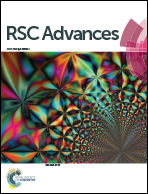Co-treatment with sulforaphane–zein microparticles enhances the chemopreventive potential of zinc in a 1,2-dimethylhydrazine induced colon carcinogenesis rat model†
Abstract
Decrease in plasma and tissue zinc is associated with the development of pre-neoplastic lesions, correlating well with the progression to carcinoma in the colon. There is also a decrease in antioxidant proteins like the zinc-dependent metallothionein (MT) and nuclear factor (erythroid-derived 2)-like 2 (Nrf2), because of the overwhelming oxidative stress. Sulforaphane (SFN) increases cellular antioxidant capacity by releasing Nrf2 from its inhibitory complex and prevents oxidative damage induced colon carcinogenesis. Administration of zinc also induces synthesis of MT directly and indirectly via its action on Nrf2. Because zinc and SFN both act on MT and Nrf2, we evaluated the effects of co-administration of zinc and SFN formulated as microparticles with zein in a 1,2-dimethylhydrazine (DMH) induced colon carcinogenesis rat model. Groups of rats were sacrificed after the end of four and six weeks and the appearance of non-dysplastic, hyperplastic and dysplastic types of aberrant crypts were considered as biomarkers for evaluating the process of carcinogenesis. Colonic tissue levels of MT and Nrf2 were measured along with other proteins and enzymes to evaluate oxidative stress load in the colonic tissue. The co-treatment showed significantly greater reduction in the formation of aberrant crypts along with increased induction of cellular antioxidant components compared to single treatments. This investigation supports the hypothesis that co-administration of zinc and SFN leads to an enhanced chemopreventive outcomes mainly facilitated by the induction of MT and Nrf2.


 Please wait while we load your content...
Please wait while we load your content...